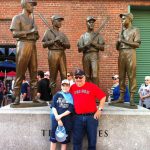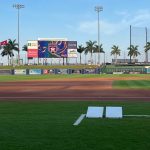Starling Marte HBP Exemplifies Major League Baseball’s Concussion Protocols
Elvin Rodriguez, a 24-year-old Tampa Bay Rays fireballer from the Dominican Republic, struggled in Sunday’s Spring Training matchup against the New York Mets. Despite looking like the hardest-throwing pitcher in Port St. Lucie, Rodriguez struggled with ball placement. Through 1.2 innings pitched, Rodriguez had already given up two home runs.
“Man he has a hose, but he doesn’t have that funky monkey,” said Craig, who sat next to me at the game. For those that don’t speak baseball junkie, Craig meant that Rodriguez throws the ball hard but lacks command.
Mets outfielder Starling Marte stepped up to the plate with one out to go in the bottom of the fifth. Rodriguez struggled to pitch inside to Marte, with the righty coming close to the innermost edge of the strike zone. The Rays pitcher wound up for a slider, hoping to trick the outfielder into a high swing. Somewhere in his windup, Rodriguez lost his grip, losing significant movement on the slider.
Thud, then deafening silence.
Rodriguez’s pitch never dipped back inside, instead rocketing into Marte’s batting helmet.
Rodriguez’s hands immediately found the back of his head as he stepped off the mound in a fret of concern. You would have thought he shot the pope.
To Marte’s credit, he took the plunk like a champ. He never went down, never crumpling to the ground. Instead, he put his hands on his knees, taking a moment to collect himself.
Mets third-base coach Joey Cora found the outfielder just outside the batter’s box. Cora led Marte to the locker room. Stadium attendees feared the worst.
“[Marte] looks good. They did a lot of tests on him. Doesn’t show any signs of a concussion. We’ll see how he feels tomorrow. May have gotten lucky, we’ll see. Hope so,” said Mets manager Buck Showalter after the game.
Marte did return to the lineup for Tuesday’s game against the Washington Nationals. While he ultimately was not concussed as previously feared, he underwent a plethora of tests before returning to the lineup. Marte’s immediate removal from the Spring Training matchup exemplifies Major League Baseball’s concussion protocols.
In 2011, Major League Baseball overhauled its concussion protocols. With the NFL’s absolute fumbling of their own concussion troubles looming large over the sports landscape, Major League Baseball opted to get ahead of the curb (or maybe enact a policy that should have been put into place in the 80s).
This overhaul included the implementation of the 7-day injured list for head injuries. MLB’s glossary describes the 7-day injured list as so:
The 7-day injured list is specifically for players with concussion symptoms.
Players may be placed on the 7-day injured list “retroactively,” meaning the stint is backdated to the day after the last date on which the player appeared in a game. For instance, if a player is diagnosed with a concussion on May 12 but last played on May 9, he could be placed on the 7-day injured list on May 12, retroactive to May 10. In that case, he would be eligible to return from the injured list on May 17.
The policy is meant to protect players. And thus far it has. Players can’t be taken off the injured list until they’ve stopped experiencing concussion symptoms.
Joey Ortiz is a prime example of these protocols. The Orioles shortstop hasn’t played since experiencing concussion symptoms following a groundball to the head just last week.
Orioles skipper Brandon Hyde said it could take “a little while” for Ortiz to return. He won’t play again until he stops exhibiting symptoms.
Another incident occurred the week before when new Red Sox third-baseman Justin Turner was hit in the face by a pitch from right-hander Matt Manning. Turner fell to the ground and blood poured from his jaw. Boston’s medical staff rushed to the plate, stopping the bleeding with a towel.
Turner remains out, mostly because the injury required 16 stitches to close. The injury, being a plunk to the head, sent Turner into concussion protocols, which he presumably passed.
Turner will begin wearing a c-flap helmet when he bats. The c-flap helmet features an extension that covers the jaw, perfect to protect the third baseman following his injury. Turner said he will wear the helmet following the injury but has resisted in years past because he doesn’t want anything obstructing his vision.
“We’ll see how it goes,” said Turner.
Protection is important, especially in an age where concussions loom so large in the collective public consciousness.
We all remember Tua Tagovailoa’s September concussion from his Thursday night football matchup against the Cincinnati Bengals. Tagovailoa’s fingers bent into gruesome shapes as he crumpled to the ground, a neurological reaction the immense brain trauma dealt by the hit.
Concussions are significantly easier to spot in a sport that doesn’t revolve around hitting another man as hard as possible. But they shouldn’t have to be. Sure the NFL appointed concussion spotters to get players with head injuries pulled off the field as soon as possible, but what’s the point when they miss injuries like Tagovailoa’s?
The quarterback was hit in the head the week prior, likely suffering some sort of brain damage. The quarterback never entered concussion protocols, and the Thursday night hit significantly compounded the severity of his concussion.
Tagovailoa suffered two more concussions last season. His career, and more importantly his quality of life, have degraded because the NFL didn’t protect one of its players.
Concussions may always exist throughout professional sports, but we can make strides to lessen the severity of trauma and an athlete’s exposure to future brain injuries.
Major League Baseball’s concussion protocols are a step in the right direction. Marte’s case exemplifies the strides taken by the league to protect players from concussions.


